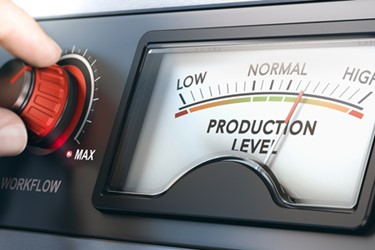7 Reasons There Was Never Going To Be A Bioprocessing Capacity Crunch

By Louis Garguilo, Chief Editor, Outsourced Pharma

In the face of adamant and public pronunciations from members of the biopharmaceutical industry, I’ve stuck now for years with this against-the-grain hypothesis:
No, a global bioprocessing-manufacturing capacity-crunch will NOT occur. Free-market economics, and our industry’s wealth, initiative and innovations, won’t allow it. And we have a reliable and expanding system of supply-chain outsourcing.
Still, I felt a bit uneasy when an editor of BioPlan Associates, Inc.’s Fifteenth Annual Report and Survey of Biopharmaceutical Manufacturing Capacity and Production (April 2018), contacted me about “your recent editorial in Outsourced Pharma regarding capacity.”
I needn’t have. The following statement was: “We’ve the research and data to further back you up.” Well, thank you, Ron Rader.
Rader is President of the Biotechnology Information Institute, a respected biopharma industry author, and BioPlan Associates’ Senior Director, Technical Research. According to Rader:
“Basically, industry perceives, reports, and expects no major capacity crunches. Productivity (mostly as titers), and the number of facilities and their capacity, continue to increase; volumetric needs for APIs – the amount of APIs needed – is tending to decrease (e.g., more niche/orphan and potent products); and single-use systems (and more modular systems in the future) make adding capacity relatively quick and easy (and determining capacity more subjective and/or simply less important).”
 Rader also mailed me the 500-plus page hardcopy report. It’s full of survey results, colorful charts, and data points. To me, it consistently draws out the seven developments that when added together, will stare down any capacity challenges that amass on the horizon. I’ll follow this with another article including more of that data, but this example will start us off here:
Rader also mailed me the 500-plus page hardcopy report. It’s full of survey results, colorful charts, and data points. To me, it consistently draws out the seven developments that when added together, will stare down any capacity challenges that amass on the horizon. I’ll follow this with another article including more of that data, but this example will start us off here:
For mammalian cell culture systems, respondents – drug sponsors and CDMOs combined – reported average capacity utilization at 62.9%, a decrease from 73.6% in 2017 (and the 74.7% reported in 2016). Microbial fermentation systems utilization at 53.5% was a 3.5-point decrease from 2017, after a 7-point increase to 57.0% in 2017, from 50.0% in 2016.
The Mitigating Seven
Here’s what I’ve hypothesized all along, and is now drawn out by the BioPlan report and survey.
1. Big Pharma will become highly involved – and increasingly dominate – in what was once the “biotech” space. Once that happened, those deep pockets would make the investments that ensured there would be the capacity to manufacture – and that ultimately means sell – these new and highly profitable products. Big Biopharma has in fact been building out its own capacity, along with global CDMOs.
The report states, “In fact, most large pharmaceutical companies are now spending 40%-50% or more of their R&D on biopharmaceuticals. To facilitate this trend, incremental innovation in improved manufacturing productivity continues unabated and is a driver for many (other) biopharmaceutical trends.” The data shows an “increasing involvement and even dominance of larger companies in biopharmaceutical R&D and products marketing.” Therefore, “most every current manufacturing facility is expanding its bioprocessing capacity,” and “new and increased manufacturing capacity is being added internationally.”
2. New manufacturing technologies and devices, smart and modular facilities, higher-yield expression systems and improved process monitoring, will increase productivity (and profitability) in all facets of production. Continuous manufacturing, and particularly the expansion of single-use technologies, will dramatically increase and add to capacity solutions.
While Big Biopharma and CDMOs are still building out with large “fixed-stainless steel bioreactor-based bioprocessing systems for commercial product manufacture,” most all R&D short of commercial scale is utilizing and/or adding more single-use equipment and technologies.
Moreover, the report says, “Recently there has been a significant increase in new single-use commercial-scale manufacturing facilities under construction and coming online.” Currently, says the report, most of these are for biosimilars manufacture, but companies now must choice between building facilities and developing product in older, fixed equipment, or selecting from new single-use systems for commercial-scale product production.
3. CDMOs will build out large amounts of capacity to capture the new bio-business opportunities. The build-outs are in fact occurring globally, with perhaps best examples to date taking place in South Korea, with Samsung and Celltrion. Indeed, service providers are becoming early adopters of the new processing and manufacturing technologies.
4. Smaller batch sizes and targeted patient populations (e.g., orphan indications) reduce the needed capacity per new drug entity. New technologies match these smaller manufacturing runs, and more frequent product changes. Actually, both smaller-market medicines and larger ones (see directly above) will be powered by new manufacturing prowess as they come along.
5. More streamlined and strategic internal pipelines (i.e., faster failing of projects in development), and M&A where large acquirers cut pipelines of acquired companies, will lesson development and manufacturing capacity burdens.
6. More biopharmaceuticals will make it to market, but there will not be an “explosion” of new products that collapses capacity. Instead – as usual – the approval of products will continue on a more orderly – and telegraphed – path, providing time and planning for drug owners and CDMOs.
There were 34 biopharmaceutical products approved by the FDA in 2017; significant, but no tsunami. (The number was 24 in 2016.) The report forecasts the market for biopharmaceuticals will continue to grow by around 12% to 15%. But rather than indicate capacity issues, conversely this potential growth will ensure biopharma companies plan for, build-buy-or-borrow the requisite manufacturing means to keep the products rolling out and the sales rolling in – even if that means at times, as the report mentions, diverting resources from small molecules.
According to the report, there are thousands of drugs in R&D stages currently, with around 40% of those biopharmaceuticals. Already, the report assesses the worldwide biopharmaceutical market at >$250 billion. Monoclonal antibodies (mAbs) alone have reached about $90 billion in annual sales. All told, the biopharmaceutical market is now about 25% of the world’s total pharmaceutical market, which the report estimates at about $1 trillion per annum.
Nobody is saying there isn’t every reason to take heed of this still relatively young biopharma industry’s growth trajectory, or suggest the industry – sponsors and providers alike – can be reactive instead of proactive to developing dynamics.
7. Finally, we’ll let it suffice to note the FDA is actively working to encourage the use of new technologies, to engage with drug sponsors and their contract partners, and work to streamline the bio-product approval process for both innovative and bio-follow-on products.
This, though, is a delicate balancing act for the agency. On the one hand, in light of serious quality issues arisen recently from countries like China and India – where much of the increase in biogenerics and/or biosimilar manufacturing capacity is forecast to take place – the agency cannot move too fast at the risk of putting patient populations in harm’s way. On the other, it needs to do as much as possible to ensure patients get access to all these remarkable bio-drugs as soon as possible.
A Final Word
The Fifteenth Annual Report and Survey of Biopharmaceutical Manufacturing Capacity and Production (April 2018) is a comprehensive and balanced report, with insight on biopharmaceuticals, biogenerics, biosimilars, and the important sub-categories within those delineations. It does, for example, point out there are some advancing “outlier areas in terms of capacity concerns, most particular in cellular/gene therapy areas.”
But within our hypothesis, we know market forces and the drive for new products, more markets and enhanced profitability, will take care of these challenges as well.
----------
Earlier selected “capacity crunch” editorials in Outsourced Pharma:
Time To Silence Capacity Alarms For Bioprocessing?
BioPharma Fears CMO Capacity Crunch
What Is Supply Chain Capacity In 2017?
New U.S And Canadian Facilities Boosting Biologics Capacity
Trending: Supply Chain Capacity, Value Calculations, And Serializatio
